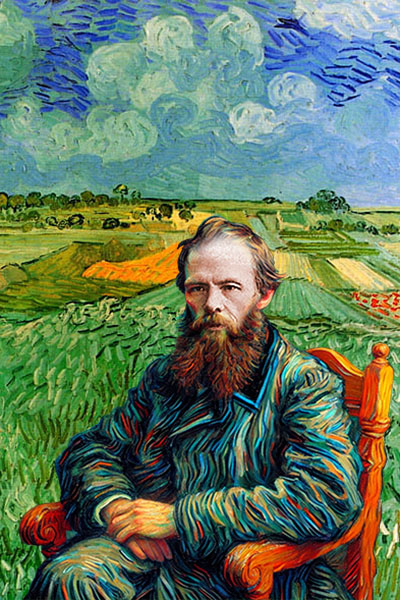Fyodor Dostoyevsky famously said that ‘Beauty will Heal the World’
A profound and uplifting declaration, but in which way could beauty alone possibly heal the world? And how could it heal those who suffer, or have suffered from deep betrayal in their closest, personal relationships?
To find answers to these questions, it is helpful to consider the meaning of beauty for Dostoyevsky, and also for others who wrote about this subject.

The Beauty and Value of Love.
Dostoyevsky declared that ‘Beauty will Heal the World’, encompassing a great deal in his definition of what beauty is. The highest ideal of beauty must be love, because if not that, than what else? We know that in his books, Dostoyevsky writes about love in human relationships, and he writes about all aspects of love with great understanding and depth. The capacities of the human heart at its best (and at its worst) is a recurring subject in his writing, and he compels us to see that the beauty of those with pure hearts, who love fully and deeply is the only thing that could ever heal the world.
In The Brothers Karamazov, Father Zosima is a central figure of compassion and spiritual wisdom who embodies a profound and active love for others. He defines the characteristics of active love, and teaches that love like this heals and transcends human potential.
“If you love all things, you will also attain the divine mystery that is in all things. For then your ability to perceive the truth will grow every day, and your mind will open itself to an all-embracing love”
~ Fyodor Dostoyevsky
Father Zosima is very elderly and is slowly dying, but he connects with those who seek his counsel and teachings with warmth and intimacy. His wisdom and tender but truthful teaching exemplify a love that is deeply personal to those who he speaks with. He speaks about love as a conscious act, to be lived daily, rather than love which is no more than the temporary dreams of romance or idealism.
“In comparison to love in dreams, active love is a cruel and frightening thing.. Active love involves work and self-mastery.”
~ Fyodor Dostoyevsky
This kind of love, free of conditions, free of obligations to reciprocate it, free of manipulation and expectations, is pure love and often difficult to practice in romantic relationships.
In his book ‘The Devils’, Lizaveta, a captivating and intelligent young woman falls in love with the charming and charismatic Stavrogin. He is a part of a newly formed revolutionary group in town, and he seems to live a life of excitement which she lacks. He harbours many secrets, some quite horrifying, and despite of herself, Liza is drawn in to unravel the mystery of him.
Initially her love for him has pure motives, her passion and idealism fuels a fascination which she confuses for love. As it becomes clear that Stavrogin has kept from her his marriage to a woman he married as a bet, his exploitation of another very young girl, and more, her love for him becomes corrupted by resentment and desire for revenge at his deception toward her. The love she felt for him was never returned, and distraught she meets a tragic end.
Similarly, Prince Myshkin in Dostoyevsky’s novel ‘The Idiot’ portrays a character who is deeply empathetic, with a heightened sensitivity to life and to nature around him, as he perceives it. He finds appreciation and joy in all aspects of every day life, and solace in the simplicity of nature and innocence of human kindness. In everyone, he sees a profound beauty.
“Yes, there is something beautiful in every person, even the most sinful person, and if you look closely, you will find something worth loving.”
~ Fyodor Dostoyevsky
Liza and Myshkin both embody love, empathy and idealism but both meet tragic fates, in different ways. In light of Dostoyevsky’s statement that ‘Beauty will Heal the World’ their stories seem paradoxical, as their capacity for love and beauty leaves them vulnerable and, in the end, leads to suffering.
In which way then, does Dostoyevsky conceive that healing could come from this kind of love ?
Healing and Beauty from Suffering for Love
Perhaps Dostoyevsky suggests that while the love and beauty of good people may not necessarily protect them from the harsh and cruel realities of the world, it may serve as a call to others, to strive for a higher vision of humanity. Their demonstrated love in the way they interact with the world, may inspire moments of insight and reflection in those who witness it, offering glimpses into the world as it can be. The beauty of those who love deeply may be seen as a light and an inspiration to healing the world.
It is also true that beauty and love often require profound sacrifice. The suffering from loss of love, the highest ideal of beauty, is a testament to its radiant value in a world that doesn’t know how to appreciate it fully.
In presenting the beauty of deep love, Dostoyevsky draws attention to its preciousness. The loss of love, no matter the circumstance, invokes deep emotional suffering, as we are forced to see the devastating reality of what is. The pain of this may seem unbearable, and we fear it will never end.
The depth of this pain also gives us moments of sublime clarity, we discover truths and ‘bottom lines’ that we would never see otherwise. There is beauty in experiencing our feelings in a pure and raw state, we see the truth beneath them, and our own capacity for love.
In this way we are challenged to value and protect the beauty of love in ourselves and in others, a realisation which transforms and illuminates the way forward. We can answer the invitation to strive toward greater compassion and understanding, urging us to honour beauty and love in our own lives more fully.
The Healing Beauty of the Natural World
“Love all God’s creation, both the whole and every grain of sand. Love every leaf, every ray of light. Love the animals, love the plants, love each separate thing. If thou love each thing thou wilt perceive the mystery of God in all; and when once thou perceive this, thou wilt thenceforward grow every day to a fuller understanding of it: until thou come at last to love the whole world with a love that will then be all-embracing and universal.”
~ Fyodor Dostoyevsky in the Brothers Karamazov
Beauty that comes from the spectacular revelations of the natural world; a breath taking sunrise, the early signs of spring, the unfolding of flowers, the awesome forces of nature, thunderstorms, the vast night sky. Healing through the senses, through realising that we are a part of a larger whole, that the sun rising above the sea, land and cityscape illuminates us all, the stars we wonder at, belong to us all.
Artistic Beauty and Inspiration
The beauty of art, music, books, films; these heal by inspiring and elevating us to new and richer ways of seeing and acting in the world.
“Beauty is a shared language of transcendence that connects us to the eternal and prompts us to consider more than merely earthly concerns”
~ ‘Beauty’ by Roger Scruton
Beautiful works of art, music, and literature have a unique ability to uplift and heal us by engaging our emotions, inspiring our minds, and connecting us to something larger than ourselves. This transformative power comes from their capacity to express truths about the human experience, resonate with our inner lives, and open healing pathways for emotional release and insight.
Standards of Beauty in Healing
In his book ‘Beauty’, Roger Scruton writes that in aesthetic evaluations, we consider symmetries, harmonies, proportions but also the lack of those things. This helps us to establish the difference between what is simply ‘beautiful’ and what we may call ‘sublime.’ He invites us to consider the elegant fugues of Bach, the serene Madonna’s of Bellini, or the gentle verses of Verlaine, which show beauty in symmetry and grace. In contrast, works like King Lear or Tchaikovsky’s Sixth Symphony (or Sex Pistols’ My Way) challenge and disturb our expectations, stirring us by breaking away from tradition and the usual ideas of beauty as orderly and pleasing.
We can see immediately, that there is no way to fix a standard of what is beautiful, and if we tried, our perception and experience of beauty would be coloured or even fixed by the rules of others. Beauty does not follow orderly rules, it either is, or it is not. They way we perceive beauty and its power to heal us by comforting, calming, validating, or stirring up our spirit is in our individual experience and response to it.
The Beauty of Passion
In Dostoyevsky’s ‘the Brothers Karamazov’, Mitya’s passionate nature drives much of the conflict in the novel, especially in his relationships. His intense love for Grushenka, his volatile relationship with his father Fyodor, and his rivalry with his brother Ivan push him into impulsive, often self-destructive actions. He’s ruled by his desires and emotions, leading him to violence, jealousy, and moments of despair.
This passion becomes the very thing that traps him, especially when he’s wrongfully accused of murdering his father, a crime his intensity makes plausible in the eyes of others.
However, while his passion often manifests destructively, it also makes him deeply sensitive and remorseful. Mitya feels every emotion intensely, which leads him to moments of regret and a longing for inner peace. His passion, then, sets up both his fall and his desire for redemption, preparing him for a transformative sacrifice at the end of the book.
In each of these examples, both Dostoyevsky and Scruton present various aspects of beauty which we find within our own hearts, the love we witness in the actions of others, the restorative beauty we find in nature, the re-energising beauty of art, music, written works, and the passion we find in our own spirit. It is this which heals those who are brave enough to open their hearts to beauty, and it is only this which could ever point the way to healing the world as a whole.
